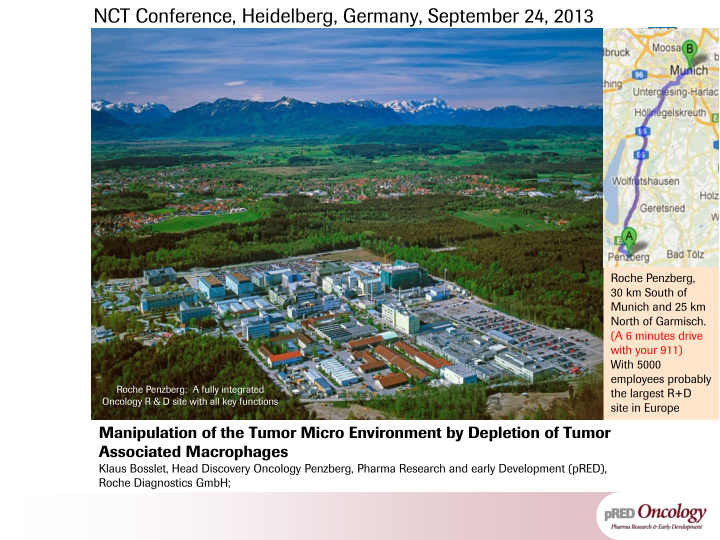



NCT Conference, Heidelberg, Germany, September 24, 2013 Roche Penzberg, 30 km South of Munich and 25 km North of Garmisch. (A 6 minutes drive with your 911) With 5000 employees probably Roche Penzberg: A fully integrated the largest R+D Oncology R & D site with all key functions site in Europe Manipulation of the Tumor Micro Environment by Depletion of Tumor Associated Macrophages Klaus Bosslet, Head Discovery Oncology Penzberg, Pharma Research and early Development (pRED), Roche Diagnostics GmbH;
Vision – where the science is driving us Understand patients and their disease to achieve CURE Tumor-Micro- Cancer Dysregulated Environment Immunotherapy cell signaling (TME) + + Modulate immuno Cancer cell-directed targets Engage host immune response via suppressive TME • Signalling inhibition Systemic modulation of immunity • Elimination and switching of (e.g. ALK; HER3) Tumor targeted immune modulation M2 macrophages • Apoptosis induction Glyco-enhanced Abs • (e.g. CSF1R Mab, AICs) (e.g. targeted IT) • Cytokine Ab fusions • Anti-Angiogenesis • Tumor Suppression T-cell bispecific Abs • (e.g. Ang2/VEGF Mab) (e.g. MDM2) Individually necessary but not sufficient. CURE requires a multi-paradigm approach. Confidential information – do not copy or distribute 2
Modulation of the Tumor Micro Environment Evolutionary Neo-Organ Treatment Barriers in Tumor Micro Environment Tumor heterogeneity: Molecular and cellular heterogeneity of tumor cell population => limits efficacy of targeted signal transducing and apoptosis inducing drugs Cancer initiating cells: A quiescent cell within the tumor micro environment with the potential to generate a new tumor being vastly resistant towards anti proliferative drug therapy Tumor supportive ECM: Connective tissue and CAFs generate a pro-tumorigenic milieu, produce growth factors contributing to resistance towards targeted drugs Aberrant vascular network: Limits accessibility for both low molecular as well as high Mikala Egeblad,1,* molecular weight drugs Elizabeth S. Nakasone, 1,2 and Zena Werb3,* Immuno suppressive phenotype: Accumulation of anergic immune and inflammatory cells within the tumor mass (T-reg and M2 M accumulation) Cancer drugs with „step change potential“ => T-cells activated by peripheral immunisation show limited efficacy in the established tumor micro environment have to overcome these Treatment Barriers
Tumors escape host immune response by inducing an immuno- suppressive Tumor Microenvironment (iTME) by recruitment of myeloid cells Tumor Immunity Immune Suppression IL-2, IFN- γ … Th CTL NK TAM e.g. IL-10, TGF- β , CCL- 2 … B M2c-M MDSC DC Treg Strategy: Target myeloid cells Enable effective anti-tumor immune - First in class opportunity response by targeting key - Tumor specific immunosuppressive myeloid cells - Low risk for autoimmunity 4
CSF-1R as Survival and Differentiation Factor for TAMs Tumor associated macrophages are alternatively activated M2 - Mφ M2- Mφ can be discriminated from M1 - Mφ by differential expression of scavenger receptor CD163 adapted from Pollard Nat Rev. Immunol. 2009 Monocyte CD68 CD68 Survival Differentiation M2 M1 Inflammatory Alternatively activated macrophage (M1) macrophage (M2) Tumor-eliminating Tumor-promoting engaging Mabs huMab CSF-1R RG7155 Depletion of M2- Mφ by anti-CSF-1R therapy offers opportunity to inhibit various signaling and effector molecules at the same time to target genetically stable cells in contrast to genetically instable tumor cells
Colony-Stimulating Factor-1 Receptor structure Binding of CSF-1 or IL-34 induce homodimerization CSF-1R CSF-1/ IL-34 6 Adapted from Hamilton J Nature Rev Immunol . 2008; 8(7):533-544
RG7155, a novel humanized FIC anti-CSF-1R mAb Highly potent, specific and purely antagonistic CSF-1R inhibitor Summary of key data for RG7155 ligand binding (D1-D3) Isotype: IgG1 Binding to domain in CSF-1R ECD: domain RG7155* D4/D5 Fab Fragment Affinity to human CSF-1R (Biacore): <1nM Light chain dimerization interface Affinity to Cynomolgus CSF-1R (Biacore): <1nM (D4 and D5) Inhibition of pCSF-1R*: <2 nM Inhibition of CSF-1/CSF-1R complex formation IC 50 :* <1 nM Monocyte survival assay IC 50 : <1 nM Osteoclast differentiation assay IC 50 : <3 nM Activation of monocytes: none Heavy chain NIH3T3 CSF-1R (L301S,Y969F) viability IC 50 : <100nM * Chimeric antibody variant Data: Kaluza, Scheiblich, Lanzendörfer, Fertig/Runza and Dimoudis labs, Crystal structure: J. Benz and I. Gorr and team pRED Basel and Penzberg
RG7155 targets essential Mφ pathway RG7155 induces cell death of M2-like CSF-1R + CD163 + Mφ M2 p-value 0.11 CSF-1 CSF-1R + CD163 + Mφ * p-value 0.02 * % of all cells Monocyte GM-CSF M1 CSF-1R - CD80 + Mφ *adapted from J. Pollard Nat Rev Immunol. 2009; 9(4):259-270 Data: Valeria Runza lab pRED Penzberg 8
Anti – CSF-1R mAb in transgenic BC model Targeting mouse CSF-1R enhances efficacy of chemotherapy p=0.001 100 Control ab anti-CSF-1R 80 Control ab + Cisplatin 60 anti-CSF-1R + Cisplatin 40 % survival 20 0 0 10 20 30 40 50 60 70 Days after initiation of treatment Karin deVisser lab Netherlands Cancer Institute, Amsterdam 10 Oral Presentation Metamia Ciampricotti, Keystone Symposium Dublin 2012
Acknowledgement: Carola Ries, rPL Michael Cannarile, BML Dominik Rüttinger, TML and the many other colleagues of the CSF1R project team 11
Recommend
More recommend